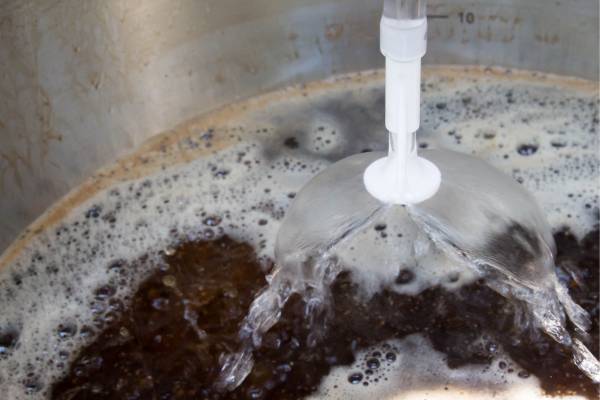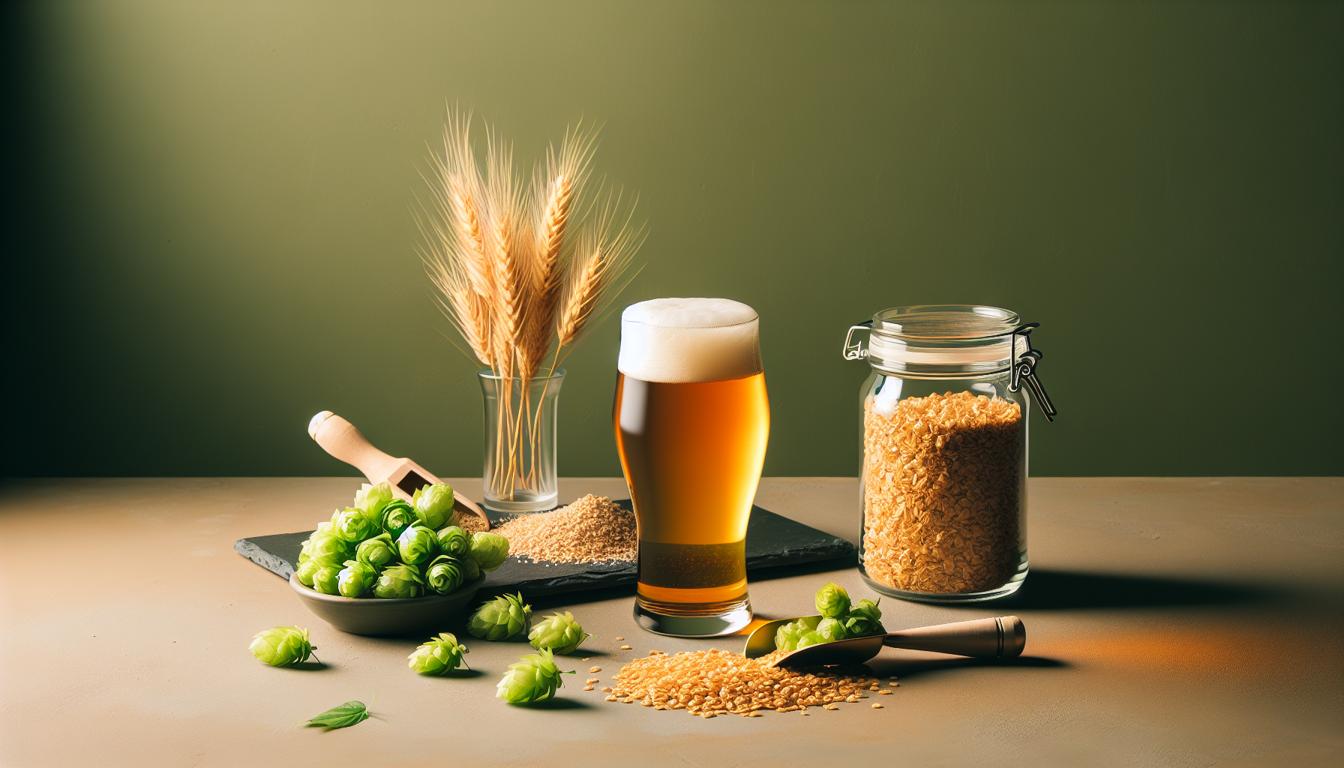American Lager is a classic beer style that has been enjoyed by beer enthusiasts for many years. It originated in the United States during the late 19th century, when German immigrants brought their brewing techniques and recipes with them. This style quickly gained popularity and has since become one of the most widely consumed beer styles in the country.
American Lagers are known for their light and crisp flavor profile, making them perfect for those who prefer a refreshing and easy-drinking beer. They are typically pale yellow in color with a clean and subtle malt character. The use of American hops gives this beer style a mild bitterness and a subtle aroma.
In this article, I will guide you through the process of brewing your own American Lager at home. I will share with you my personal recipe and provide you with some expert tips and tricks along the way. So grab your brewing equipment and let’s get started!
Ingredients
To brew a delicious American Lager, you will need the following ingredients:
– 8.5 lbs (3.9 kg) of Pilsner malt: This base malt will provide the majority of the fermentable sugars and contribute to the light color and clean flavor of the beer.
– 1 lb (0.45 kg) of Corn sugar: This adjunct will help to lighten the body of the beer and add a touch of sweetness.
– 1 oz (28 g) of Saaz hops: These traditional Czech hops will provide a mild bitterness and a subtle floral aroma.
– 1 package of Lager yeast: Choose a clean and neutral yeast strain that is suitable for lager fermentation.
– 1/2 tsp of Irish moss: This fining agent will help to clarify the beer during the fermentation process.
– 5 gallons (19 liters) of water: Make sure to use filtered or spring water to avoid any unwanted flavors.
Equipment
Before we dive into the brewing process, let’s make sure you have all the necessary equipment. You will need:
– A 10-gallon (38-liter) brew kettle: This will be used to boil the wort and add the hops.
– A fermentation vessel: A glass carboy or a plastic bucket with an airlock will work perfectly for this style.
– A wort chiller: This will help you quickly cool down the wort after boiling.
– A hydrometer: This tool will allow you to measure the specific gravity of the beer and determine the alcohol content.
– A thermometer: You will need this to monitor the temperature of the wort during the brewing process.
– A racking cane and tubing: These will be used to transfer the beer from the fermentation vessel to the bottling bucket.
– Bottles and caps: Make sure to have enough clean and sanitized bottles to hold all the finished beer.
Brewing Process
Now that you have gathered all the necessary ingredients and equipment, it’s time to start brewing your American Lager. Follow the step-by-step instructions below:
Step 1: Mash
– Start by heating 3.5 gallons (13 liters) of water in your brew kettle to a temperature of 150°F (66°C).
– Add the 8.5 lbs (3.9 kg) of Pilsner malt to the kettle and stir well to ensure all the grains are fully submerged.
– Cover the kettle and let the mash rest for 60 minutes. During this time, the enzymes in the malt will convert the starches into fermentable sugars.
– After the hour is up, raise the temperature to 168°F (76°C) and let it sit for 10 minutes. This will help to denature the enzymes and stop the conversion process.
Step 2: Sparge
– Heat 3 gallons (11 liters) of water to 168°F (76°C) in a separate vessel.
- Slowly pour the sparge water over the grains in the kettle, making sure to distribute it evenly.
- Collect the runnings in a separate container and set aside for later use.

Step 3: Boil
- Transfer the collected runnings back into the brew kettle and bring it to a boil.
– Add 1 oz (28 g) of Saaz hops to the kettle and set a timer for 60 minutes.
- During the boil, make sure to stir occasionally to prevent scorching and to achieve a good hop extraction.
– With 15 minutes left in the boil, add 1/2 tsp of Irish moss to help clarify the beer.
– After the hour is up, turn off the heat and let the wort cool down to 70°F (21°C).
Step 4: Fermentation
- Transfer the cooled wort to a sanitized fermentation vessel, leaving behind any trub and hop debris.
– Pitch the Lager yeast into the vessel and seal it with an airlock.
– Place the vessel in a cool and dark location, ideally at a temperature of 50-55°F (10-13°C).
– Let the beer ferment for 2-3 weeks, or until the specific gravity remains stable for several consecutive days.
- Once fermentation is complete, transfer the beer to a secondary vessel for lagering. This can be done by using a racking cane and tubing to carefully siphon the beer.
– Store the secondary vessel in a refrigerator at a temperature of 32-40°F (0-4°C) for 4-6 weeks. This extended cold storage will help to further clarify and condition the beer.
Step 5: Bottling
- Prepare your bottles by cleaning and sanitizing them thoroughly.
– Dissolve 3/4 cup (150 g) of corn sugar in 2 cups (480 ml) of boiling water to create a priming solution.
- Transfer the beer from the secondary vessel to a sanitized bottling bucket, leaving behind any sediment.
- Carefully add the priming solution to the bottling bucket and stir gently to ensure even mixing.
– Attach a bottling wand to the end of the tubing and fill each bottle, leaving about 1 inch (2.5 cm) of headspace.
– Cap the bottles securely and store them at room temperature for 2-3 weeks to allow for carbonation.
Conclusion
Congratulations! You have successfully brewed your own American Lager. Now it’s time to sit back, relax, and enjoy the fruits of your labor. Remember, brewing beer is both an art and a science, so don’t be afraid to experiment and make adjustments to the recipe as you see fit.
Here are some key points to keep in mind when brewing an American Lager:
- Use high-quality ingredients, especially the Pilsner malt, as it plays a crucial role in the flavor and character of the beer.
- Pay close attention to the mash temperature and duration to ensure proper conversion and extraction of sugars.
- Keep fermentation temperatures in check, as lagers require cooler temperatures for optimal yeast activity.
- Be patient during the lagering process, as this is where the beer will develop its clean and crisp character.
- Proper sanitation is essential at every step of the brewing process to prevent off-flavors and infections.
I hope you find this recipe and guide helpful in your brewing journey. Cheers to brewing your own delicious American Lager!
FAQs
What is the most popular American lager?
The most popular American lager is Bud Light, which consistently ranks as the best-selling beer in the United States.
What is the best lager beer in USA?
It is subjective to determine the “best” lager beer in the USA as taste preferences vary among individuals. However, some highly regarded lager beers in the USA include Yuengling Traditional Lager, Samuel Adams Boston Lager, Sierra Nevada Pale Ale, and Brooklyn Lager.
What makes lager different from beer?
Lager is a type of beer that is fermented and conditioned at lower temperatures than other beers, typically around 45-55°F (7-13°C). This results in a cleaner, crisper taste and a smoother texture compared to other beer styles. Additionally, lagers are typically bottom-fermented, meaning the yeast settles at the bottom of the fermentation vessel, while other beers are often top-fermented.
What is the #1 selling beer in America?
The #1 selling beer in America is Bud Light.
What makes an American lager?
An American lager is a type of beer that is light in color, low in alcohol content, and has a clean, crisp taste. It is typically brewed using a combination of malted barley, corn or rice, and hops. American lagers are known for their smoothness and high level of carbonation, making them easy to drink. They are often mass-produced and widely available, with brands like Budweiser and Coors being popular examples.
What beer is an American lager?
American lager is a style of beer that originated in the United States. It is a light, crisp, and refreshing beer that is typically pale yellow in color. Some popular examples of American lagers include Budweiser, Coors, and Miller.





Leave a Reply
You must be logged in to post a comment.